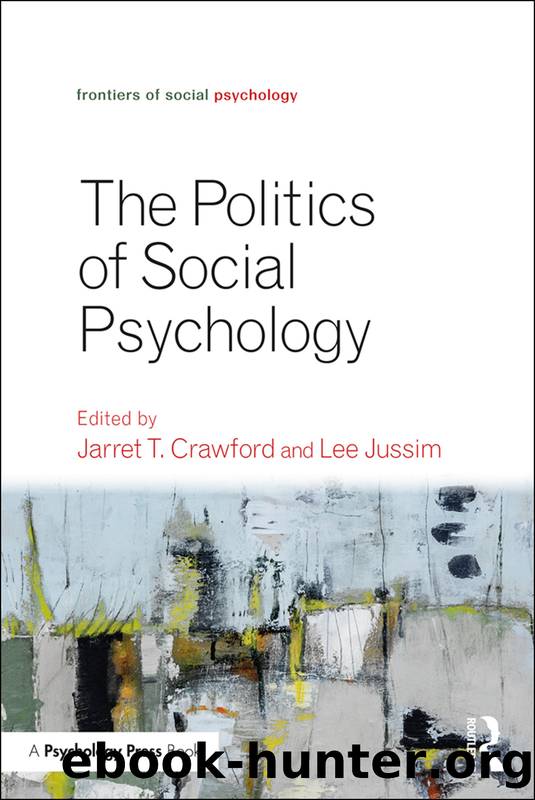Politics of Social Psychology by Crawford Jarret T.;Jussim Lee; & Lee Jussim

Author:Crawford, Jarret T.;Jussim, Lee; & Lee Jussim
Language: eng
Format: epub
Publisher: Taylor & Francis Group
Published: 2017-12-15T00:00:00+00:00
The Example of Implicit Bias Research
Pair surprising results with a timely topic and enthusiastic researchers ready to extend those results to real-world domains, and psychological research may quickly find its way into policy debates, agency rule-making, executive suites and boardrooms, and courtrooms. That has certainly been the case with implicit bias research. With the aid of several psychologists who believe that new implicit measures of psychological processesâparticularly the Implicit Association Test (IAT) and the shooter bias paradigmâhave opened the door to the subconscious and its many influences on behavior, a new understanding of the power of race and gender to bias behavior has entered public consciousness and public policy discussions.
In conjunction with activation of the first Project Implicit website in 1998 and publication of the first IAT results, Drs. Greenwald and Banaji held a press conference in which they declared that the race IAT reveals unconscious prejudice that affects â90% to 95% of peopleâ (http://www.washington.edu/news/1998/09/29/roots-of-unconscious-prejudice-affect-90-to-95-percent-of-people-psychologists-demonstrate-at-press-conference/). Shortly thereafter, Dr. Greenwald appeared on an NBC News segment demonstrating the IAT as a measure of unconscious prejudice. In March of 2000, Drs. Banaji and Greenwald appeared on NBCâs Dateline program discussing IAT research, with Dr. Banaji characterizing the test as an examination of how âfair are we being when we judge a person,â and Dr. Greenwald giving an example of the wrongful shooting of a black suspect by police as an example of how the bias measured by the IAT can affect behavior. Since those early appearances, Drs. Banaji and Greenwald have given many statements for television shows, radio programs, and print articles about the IAT, what it measures, and the behavioral consequences of implicit bias as measured by the IAT. In their book published in 2013 for a general audience, Banaji and Greenwald write, after detailing disparities in housing, employment, healthcare, and imprisonment, that âit is reasonable to conclude not only that implicit bias is a cause of Black disadvantage but also that it plausibly plays a greater role than does explicit bias in explaining the discrimination that contributes to Black disadvantageâ (Banaji & Greenwald, 2013, p. 209).
The public policy agenda behind Drs. Greenwald and Banaji publicity efforts is no secret. According to Dr. Banaji, â[t]he central idea is to use the energy generated by research on unconscious forms of prejudice to understand and challenge the notion of intentionality in the lawâ (Potier, 2004). To this end, Dr. Greenwald has given presentations at American Bar Association conferences aimed at educating lawyers on legal implications of the IAT research, and both Dr. Greenwald and Dr. Banaji have written articles for legal audiences (e.g., Greenwald & Krieger, 2006; Kang & Banaji, 2006; Kang et al., 2012).
Drs. Banaji and Greenwald (and others) have taken their education efforts to courts as well. Dr. Banaji testified about the possible influence of implicit bias on jurors in a death penalty case in New Hampshire, and Dr. Greenwald has now appeared as an expert witness in several legal cases (and in some of those cases, the present author submitted
Download
This site does not store any files on its server. We only index and link to content provided by other sites. Please contact the content providers to delete copyright contents if any and email us, we'll remove relevant links or contents immediately.
Spare by Prince Harry The Duke of Sussex(4798)
Machine Learning at Scale with H2O by Gregory Keys | David Whiting(3651)
Fairy Tale by Stephen King(2960)
Will by Will Smith(2586)
Hooked: A Dark, Contemporary Romance (Never After Series) by Emily McIntire(2426)
The Bullet Journal Method by Ryder Carroll(2405)
Rationality by Steven Pinker(2153)
It Starts With Us (It Ends with Us #2) by Colleen Hoover(2048)
Friends, Lovers, and the Big Terrible Thing by Matthew Perry(2011)
Can't Hurt Me: Master Your Mind and Defy the Odds - Clean Edition by David Goggins(2007)
The Becoming by Nora Roberts(1925)
Love on the Brain by Ali Hazelwood(1823)
HBR's 10 Must Reads 2022 by Harvard Business Review(1702)
The Strength In Our Scars by Bianca Sparacino(1700)
A Short History of War by Jeremy Black(1676)
Leviathan Falls (The Expanse Book 9) by James S. A. Corey(1529)
515945210 by Unknown(1524)
Bewilderment by Richard Powers(1453)
443319537 by Unknown(1400)
